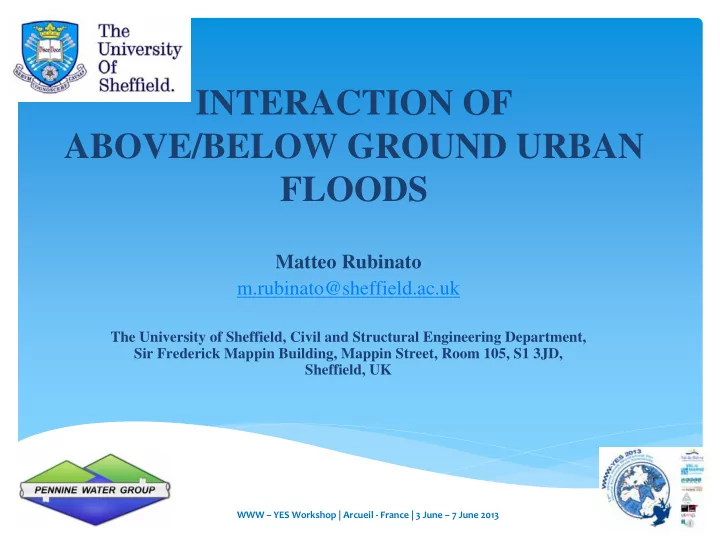

INTERACTION OF ABOVE/BELOW GROUND URBAN FLOODS Matteo Rubinato m.rubinato@sheffield.ac.uk The University of Sheffield, Civil and Structural Engineering Department, Sir Frederick Mappin Building, Mappin Street, Room 105, S1 3JD, Sheffield, UK WWW – YES Workshop | Arcueil ‐ France | 3 June – 7 June 2013
INTRODUCTION The frequency and severity of pluvial flood events is expected to increase worldwide due to some important factors: ∗ Climate change (short duration high intensity rainfall events are becoming more frequent , like for example the July 2007 flood in South Yorkshire, UK); ∗ Changes in urban hydrology , especially regarding groundwater level and infiltration (Ashley et al. 2005); ∗ The increase of urbanisation and urban creep ; ∗ The deterioration of existing sewer systems and changes in local flood pathways and urban form. WWW – YES Workshop | Arcueil ‐ France | 3 June – 7 June 2013
URBAN FLOODING Pluvial flooding occurs when sewers are overwhelmed by heavy rainfall. The process of urban flooding is combination of surface water flow and water that flows from the sewer system. Complex interaction This research includes an experimented study to investigate aspects of flooding and surcharge in a pipe network which mimics part of a full scale system. WWW – YES Workshop | Arcueil ‐ France | 3 June – 7 June 2013
EXAMPLES WWW – YES Workshop | Arcueil ‐ France | 3 June – 7 June 2013
IMPROVING URBAN DRAINAGE SYSTEMS Understanding the hydraulic performance of the physical system and its interaction with the environment is a prerequisite for effective planning and management of urban drainage and storm water systems. COMPUTER MODELLING PLAN ASSESS REASSESS MEASURES And / Or RISK RISK PHYSICAL MODEL STUDIES WWW – YES Workshop | Arcueil ‐ France | 3 June – 7 June 2013
EXPERIMENTAL FACILITY SCHEME WWW – YES Workshop | Arcueil ‐ France | 3 June – 7 June 2013
EXPERIMENTAL FACILITY WWW – YES Workshop | Arcueil ‐ France | 3 June – 7 June 2013
INPUTS TO SYSTEM Based on simulation using INFOWORKS . To determine flow hydrographs, Infoworks uses the following specific parameters and values: ∗ Dimensions and characteristics of the sewer system; ∗ Intensity of measured rainfall events (mm/h) and recorded water depth (mm); ∗ Time of beginning of the rainfall event and its duration; ∗ Antecedent conditions, obtained calculating the UCWI (Urban Catchment Wetness Index). WWW – YES Workshop | Arcueil ‐ France | 3 June – 7 June 2013
RAINFALL SIMULATIONS ∗ The rainfall events for the simulations are based on rain gauge data taken within the catchment. Events of duration 15 ± 1, 30 ±2, 45 ±1 and 60 ± 2 minutes have been used in this work. WWW – YES Workshop | Arcueil ‐ France | 3 June – 7 June 2013
MODIFICATION LABVIEW INTERFACE Qc Qa Qb WWW – YES Workshop | Arcueil ‐ France | 3 June – 7 June 2013
EXAMPLE RESULTS Example comparison of velocity values within the urban drainage system using InfoWorks simulations and the physical model results. WWW – YES Workshop | Arcueil ‐ France | 3 June – 7 June 2013
CORRELATION COEFFICIENT R 2 FOR SIMULATED AND MEASURED RESULTS Where: ∗ m t = value measured in the physical model ; ∗ p t = value obtained from the computer model ; ∗ N = the total number of samples in data set . WWW – YES Workshop | Arcueil ‐ France | 3 June – 7 June 2013
HYDRAULICS WWW – YES Workshop | Arcueil ‐ France | 3 June – 7 June 2013
PIV (Particle Image Velocimetry) It is an image based method used to determine instantaneous velocity fields by measuring the displacement of a cluster of tracers in a fluid. EXPERIMENTAL SETUP ∗ Particles (Velocity Lag, Scattering properties, Homogeneous distribution); ∗ Camera (Speed, Resolution, Low noise of electronics); ∗ Camera lens (As few aberrations as possible, Focal length); ∗ Triggering (Accurate, Stable); ∗ Calibration (Relation true particle position – particle image position) ∗ Computer with appropriate soft-hardware WWW – YES Workshop | Arcueil ‐ France | 3 June – 7 June 2013
SUMMARY � The application of a physical model of a sewer system has been illustrated: an experimented study to investigate aspects of flooding and surcharge in a pipe network. � Validation of a computer modelling software and potential application for RTC � Good agreement between Infoworks simulations and laboratory measured flows and hydraulic features ( velocity for the conditions into the pipes ). � Future work to include analysis of surface flows and 1D/2D modelling. � Potential application for PIV technique and comparison with digital maps generated by computer software . WWW – YES Workshop | Arcueil ‐ France | 3 June – 7 June 2013
Thank you for your attention WWW – YES Workshop | Arcueil ‐ France | 3 June – 7 June 2013
Recommend
More recommend